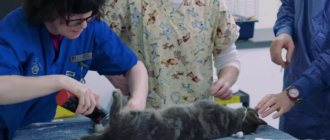What is castration
Castration of a cat is a simple operation to remove the testicles of male cats. It is performed under intravenous anesthesia and lasts up to 20 minutes. During the procedure, the cat is put into an anesthetic sleep, a small incision is made on the scrotum and the testicles are removed; no stitches are placed. The goal is to stop the animal’s reproductive ability, suppress sexual desire, and eliminate unacceptable behavior habits.
An uncastrated cat constantly marks the premises
The operation is not advisable if the pet lives in the private sector or on the ground floor of an apartment. After all, he can go out and satisfy his sexual needs. Pedigree cats that participate in breeding production are also not subject to manipulation.
Important! Males undergo castration, cats undergo sterilization.
Tumors, hematomas, filling of the scrotum with blood after castration.
The previous chapter of the article is about possible complications during castration of cats - Pain after castration.
A fairly common complication after castration of a cat is the appearance of noticeable tumors, hematomas (bruises) and filling of the scrotum with blood.
Most often, such deviations occur in large cats that are castrated as adults. Their blood vessels in the scrotal sac are large and therefore more prone to increased bleeding when cut. In the postoperative period, the causes of bleeding and swelling of the scrotum may be increased physical activity (the cat runs too much, makes sudden movements, jumps) or licking postoperative wounds.
In rare cases, filling the scrotum with blood can be a sign of blood incoagulability; attention must be paid to this. Veterinarians often diagnose bleeding disorders during surgery. It is caused by such reasons as poisoning with rat poison (from rat bait), platelet deficiency, hemophilia, and so on. Because of this, bleeding does not stop in a timely manner, and the scrotum becomes filled with blood during or after castration.
If a cat begins to bleed into the scrotal sac, it is usually clearly visible. The cat's scrotum swells, increases in size, it can become very red and look like a solid bruise. Often, owners call veterinarians to clarify whether their cat has been neutered because the swollen, blood-filled scrotum looks the same as it did before the operation, when the testicles were in it. Cats with an inflamed scrotum often show signs of pain. They can breathe heavily, restlessly wander around the rooms (“can’t find a place for themselves”), cats have a tense gait in their hind legs, and a refusal to sit in a normal position. Often cats try to be secluded, hide in dark places, some may show aggressiveness when trying to touch them. Many cats begin to intensively lick the inflamed area, which only increases the inflammation, further injuring the scrotum.
As a rule, swelling and inflammation go away on their own, and the scrotum shrinks when the blood that gets into it is absorbed by the cat's body. Therefore, in most cases, no special treatment is required. To alleviate your cat's condition, it is enough to give him cat painkillers (prescribed by a veterinarian), limit his physical activity and prevent him from licking surgical sutures.
We recommend reading: Claw sharpener for cats
Continuation of the article about possible complications during castration of cats - Infection of sutures after castration.
As a rule, swelling and inflammation go away on their own, and the scrotum shrinks when the blood that gets into it is absorbed by the cat's body. Therefore, in most cases, no special treatment is required. To alleviate your cat's condition, it is enough to give him cat painkillers (prescribed by a veterinarian), limit his physical activity and prevent him from licking surgical sutures.
Pros of castration
Among owners there is still a negative opinion about this procedure. However, veterinarians note a number of positive effects that the operation provides. The advantages of castration clearly make it clear why it is needed.
Cessation of vocalization
During sexual hunting, the male makes calling sounds of various tones - the voice can produce low growling calls, plaintive meows, even squeaks. The male calls the cat, constantly asks to go outside, and is eager to jump out of the window. The screams can continue for several hours; some males do not calm down even at night. Once the testicles are removed, vocalization stops.
Stops marking
An uncastrated male often marks the territory in which he lives, the liquid has a disgusting smell, and being in the room becomes unbearable. An unsatisfied individual will inevitably damage furniture and walls. Hormones also manifest themselves in disgusting behavior.
Disappearance of aggression
Unspent sexual desire causes discomfort to the cat; he can behave aggressively, rush at people and other animals. After surgery, the level of sex hormones will decrease, and the animal will look calm and affectionate. Many retain hunting skills.
Reduces the risk of disease
Neutered cats live longer than reproductive cats. Neutered cats have a reduced risk of blood diseases and cancer. Indeed, in the absence of mating, sex hormones work to destroy the reproductive organs - prostatitis and immunodeficiency develop.
If the cat's testicles are not trimmed, he will constantly ask to go outside. Accidental contact with stray cats leads to infection with diseases that affect internal organs. The most dangerous of them is viral leukemia.
Sterilization and castration of cats
Castration of a cat means deprivation of furry testes. There is no need to assume that castrated cats are deprived of all the joys of life. On the contrary, after castration, the chances of dying from urolithiasis (UCD), which occurs in many cats due to hormonal fluctuations and metabolic disorders, are sharply reduced. Operated purrs live much longer than their relatives due to the stability of hormonal levels, they no longer suffer from sexually transmitted infections, and their behavior improves.
Sterilized cat - with spermatic cords tied. The method is controversial, because after this procedure the cat continues to mark the territory and your shoes, and is able to hunt cats without procreation. It is a mistake to think that a sterilized cat suffers from the inability to procreate and lack of sex. After all, even in the wild, the male still has to win his right to the female, and not everyone succeeds in this.
Disadvantages of castration
Despite all the advantages, the procedure has a number of disadvantages. All of them are related to the health of the cat.
Development of urolithiasis
Due to decreased testosterone, the risk of developing kidney disease and stone formation increases. The release of sand in urine damages the urinary ducts. If surgery is performed at an early age, there is a risk that the urethra and bladder will not yet develop.
Important! In underdeveloped organs, stones and sand are more likely to form; surgical intervention in this case is difficult.
Decreased activity, excess weight
Changes in hormonal levels reduce the pet's metabolism, which leads to weight gain. The cat loses the need to look for a female, he becomes passive, spends a lot of time in a lying position. Obesity leads to heart disease.
Decreased activity leads to weight gain
Sterilization of a cat as an alternative to castration
Some owners categorically refuse castration as soon as they find out that their pet will be deprived of testicles. At the same time, owners are trying to solve the problem of uncontrolled reproduction. This question is especially relevant for those who have animals of different sexes living in their homes. There are only two alternatives to castration: lifelong “feeding” of hormonal pills or sterilization.
We recommend reading: Liquid Yellow Stool in a Puppy
A lot has been said about hormonal pills. If we summarize the numerous recommendations of veterinarians and experienced owners, there is no doubt that hormonal contraceptives for animals are very harmful. Practicing doctors constantly focus on the fact that to “trigger” the development of a dangerous disease, such as cancer, sometimes a one-time dose of a hormonal contraceptive is enough.
Sterilization is any method available (from a veterinary point of view) that leads to infertility of an animal. Recently, in order to mitigate the conflict between opponents of castration and its supporters, the term castration began to be deliberately replaced by the term sterilization. I must say that the method works. Castration is associated with the removal of testicles, but sterilization is a term that is not entirely clear and people are starting to ask about it. This is how, out of curiosity, a person gets a chance to learn about the true benefits of castration of animals.
Let's look at some reasons why pet owners might have a reasonable incentive to seek an alternative to neutering. If you add up all the factors and nuances, there are only two reasons: preservation of genetic material or medical contraindications to performing surgery under deep anesthesia.
The first case is rather an exception. For example, if you own a cat who, in turn, is the last representative of a breed or breed line, then the desire to preserve the genetic material is quite reasonable. In this case, temporary sterilization is used to eliminate the discomfort of the owner and the animal itself.
Medical contraindications to performing surgery under full anesthesia can be found even in young animals. Many purebred cats develop heart failure even at an early age. With such a disease, castration under deep anesthesia is dangerous, but possible. If the doctor does not intend to take risks or is not confident in the success of the operation, he will offer the owner an alternative.
The next common option in which sterilization becomes a reasonable alternative to castration is old age. Cats over 10 years old may not physically tolerate anesthesia, but their “sexual impulses” can be restrained with the help of hormonal drugs. It is important not to confuse the common pills sold in every pet store with reasonably selected hormonal therapy.
Sterilization of animals is carried out using several methods. A female can have either her ovaries or her uterus removed; this is also a method. For males, vasectomy or neutering is also a surgical procedure in which the spermatic cords are ligated. Vasectomy is performed in several ways. The spermatic cords can be tied with a thread or a knot, or cauterized using a special apparatus that solders living tissue. All types of sterilization lead to the fact that the cat remains sexually active, but cannot have offspring.
Note! Neutered cats mark their territory, may scream to invite the cat, and remain territorially aggressive.
Relatively new techniques allow sterilization and castration to be carried out under local or epidural anesthesia . These techniques are not completely approved because the cat's sensitivity is not completely reduced. While conscious during the procedure, the animal receives very strong stress, the damage from which can be greater than from anesthesia. In addition, while conscious and partially mobile, many cats escape from the operating table and injure themselves.
If your pet has contraindications to general anesthesia, then you may be offered two more innovative alternatives. Modern clinics offer animal owners services for chemical, radiation and drug sterilization of animals.
The medicinal method involves the use of hormonal drugs, which we mentioned above. With prolonged observation of the animal’s condition and trends in changes in its behavior, the veterinarian selects the correct dose and frequency of medication administration.
The chemical method of castration also involves the introduction of special medications into the animal’s body. Chemical castration and sterilization should not be compared with chemotherapy, but these procedures have something in common. By removing foreign substances into the animal’s body, its hormonal levels and behavioral factors are suppressed.
Radiation sterilization is the most “dubious” method. Perhaps the doubts are due to the fact that this method is new and little studied. The essence of the procedure is that the cat receives targeted radiation, which suppresses the work of the testes and makes the sperm lifeless.
Note! Neutered cats mark their territory, may scream to invite the cat, and remain territorially aggressive.
Age for castration
When owners decide to neuter a cat, they should be aware that there are age limits for the operation. A procedure done at the wrong time can be harmful to the health of the animal. When they decide to castrate a kitten, they look at what age its genitals formed.
Important! The owner should know at what age cats are neutered. A timely operation will keep your pet healthy.
At what age can you be neutered?
As a rule, surgery is performed on kittens older than six months, when all organs have already formed and the body has become stronger. The best age for the patient is from 6 months to a year. The testicles are removed when they have descended into the scrotum. In the kitten they are still in the abdominal cavity; the operation can have serious consequences. It will be easier for an older cat to endure anesthesia and recover.
Preparing for surgery
Having decided to undergo surgery, owners must clearly understand that castration is a surgical operation that requires adherence to a clear algorithm of actions. Having chosen a suitable veterinary clinic, before the operation it is necessary to take tests: blood, urine, a smear for sexually transmitted infections, and give the cat a cardiogram. Get vaccinated in advance, about two months in advance, or you can postpone them for a while.
It is important to approach the operation responsibly and not spare money on procedures and examinations, because the health and life of your pet depends on its successful implementation.
After anesthesia, the cat will sleep for several hours, so you need to take a carrier and a blanket to the veterinary clinic; during narcotic sleep, the body temperature drops and the pet may freeze.
Preparing the cat and progress of the operation
12 hours before the procedure, the pet should not be given food to avoid vomiting. The cat drinks water 4 hours before the clinic visit.
Working with a cat at the doctor:
- The patient is weighed and examined for external signs of a cold.
- They put him under anesthesia.
- A micro-incision is made on the scrotum, the spermatic cords are ligated, and the testicles are removed.
- A suture is usually not applied; the incision is treated with an antiseptic.
- The cat's condition is monitored until recovery from anesthesia.
Some clinics offer home surgery services. The veterinarian arrives with the necessary equipment to the location specified by the client. It is better to perform on-site surgeries on young, completely healthy cats, because in the event of complications, it will not be possible to resuscitate the animal.
If your pet quenches its thirst before surgery, there is a risk of water getting into the lungs and developing pneumonia.
The veterinarian announces the full range of examinations and how much the cat castration itself costs. Removing genitals costs less than spaying a cat.
How long does it take for cats to recover from anesthesia after castration?
How cats recover from anesthesia after castration depends on many factors, mainly the age and physiological state of the animal. Age plays a big role: the older the cat, the longer the recovery period from anesthesia.
How long does it take for cats to recover from anesthesia after castration? Typically, the effect of the drug lasts from 2 to 12 hours. Within 24 hours, the drug is completely eliminated from the body. Choleric cats recover from anesthesia faster after castration.
In some cases, cats after castration may not want to eat during the first two days, but it is important that the cat drinks water. There is no need to force feed him.
Important signs of a cat’s condition after castration, in which you should immediately contact a veterinarian:
- If your furbaby lies motionless for more than 7 hours, does not respond to stimuli and does not try to get up.
- If you notice rapid breathing and heartbeat, your heart rate is slow, your breathing is shallow, intermittent, and uneven.
- The cat does not go to the toilet in a small way or when trying to urinate, it gets nervous and screams.
In all these cases, you must immediately consult a doctor!
Features of care after surgery
Postoperative care for your cat is simple. It involves a few simple steps:
- Make sure that the pet does not lick its wound, as this place will be very itchy at first.
- They buy or make a collar that will limit the male’s movements and will not allow him to lick the sore spot.
- During the first days, the surgical site is treated with an antiseptic.
- You can feed your pet the next day and water it 4 hours after the procedure.
- The patient must be given rest, placed on a comfortable bed, and not disturbed with excessive attention.
In the first hours after the operation, the cat will feel weak and drowsy. Due to the simplicity of the operation, healing will occur very quickly.
However, the pet's agitated behavior can persist for a long time; the operation does not provide an immediate effect. This happens because testosterone, which excites the male, can remain in the pituitary gland and adrenal glands for a long time. The concentration of the hormone and, consequently, the animal’s aggression can last up to six months after the procedure.
Note! A castrated pet should be fed with special food for sterilized males to avoid the development of urolithiasis.
For preventive purposes, once a year they take a urine test, do an ultrasound of the bladder and kidneys, and an electrocardiogram. These measures will help identify urolithiasis and heart disease at an early stage.
You cannot overfeed a male, there is a risk of developing obesity. It’s worth spending more time with your pet and engaging in active games. In most operated adult males, behavior improves after removal of the testicles; the cat begins to go to the toilet only in the place designated for it.
Castration is an easy and quick way to stabilize your pet's behavior. Timely manipulation will help keep the house in order, save the owners’ nerves and the pet’s health.
The question of castration is perhaps faced by every owner. It is usually difficult to make a decision: some people think about the humaneness and ethics of the procedure in relation to a pet, some are afraid of operational risks, some do not want to interfere with nature. In order to dispel doubts, it is worth weighing the pros and cons of the operation.
First, let's figure out what castration is. In general, male castration refers to the complete cessation of sexual desire and the inability to impregnate a female .
Most often this is a surgical operation, but currently cats are also castrated with medication (temporary castration, chemical sterilization). We talked about medical castration in this article, but here we will talk about the surgical method.
Caring for a cat after castration
Castration of a cat is still an operation, albeit a fairly simple one. Therefore, the cat needs postoperative care in the first days after castration.
The cat must remain under the supervision of a doctor for at least an hour after castration. This will ensure that he recovers from anesthesia normally and there will be no complications such as respiratory or cardiac arrest.
In the first days after castration of the cat, keep the veterinarian's phone number nearby so that if complications arise, you can seek help as soon as possible.
After castration, you need to transport your cat in a special carrier. Lay a warm diaper on the bottom to absorb moisture. Cover the cat with another diaper on top and, if possible, place a heating pad next to it (from the back, since if you put it close to the incision site, this can lead to bleeding). It is better not to transport a cat after castration on public transport - this will become a source of additional stress.
Caring for your cat in the first days after castration at home is extremely important. Place your pet on a warm bedding and place a heating pad. The cat should be away from drafts. Place a bowl of water nearby.
For the first 8 to 16 hours after castration of the cat, pay attention to his heartbeat and breathing rate.
In the first hours after anesthesia, the cat’s body temperature may decrease - this is normal. If the cat’s temperature does not return to normal after 24 hours, this is a reason to sound the alarm.
An important part of caring for a cat after castration is treating the postoperative wound. Check your groin area and stitches every day to make sure there is no bleeding. 1 – 2 times a day, treat the seam with hydrogen peroxide and lubricate it with brilliant green. Levomekol ointment improves healing.
Licking the wound after castration can lead to the suture coming apart, so it is better to put a post-operative collar on the cat.
Sometimes, especially in the warm season, the veterinarian prescribes a course of antibiotics for the cat after castration (up to 5 days).
If you think your cat is acting abnormal or not feeling well after neutering, contact your veterinarian as soon as possible! It's better to play it safe once again.
Photo: pinterest.ru
How does castration occur?
Anyone who is thinking about castrating a purring pet should know how domestic cats are castrated. First of all, anesthesia is administered. The next step is to remove hair from the scrotum using a razor. Next, the doctor makes two small incisions on the skin with a scalpel, tightens the spermatic canal, and then removes the testes. In most cases, postoperative stitches are not required. The total duration of the procedure is up to 5 minutes. The described method has been tested many times in practice, so there is no danger in it. The most difficult task is removing the animal from anesthesia.











